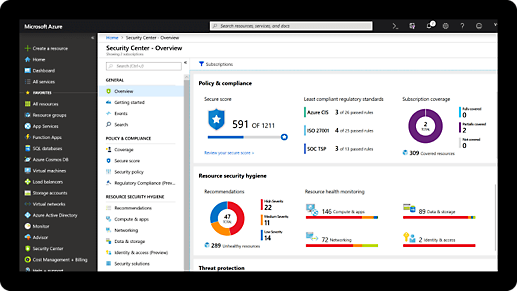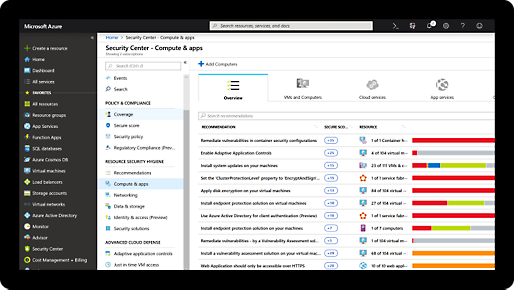Azure Cloud Services
Create highly-available, infinitely-scalable cloud applications and APIs.
Deploy highly available and scalable applications in minutes
Build the web and cloud applications you need on your terms while using the many languages we support. Simplify the management of your applications with cloud services while ensuring high availability. Scale your environment automatically based on demand and reduce costs. Automate operating system and application updates to increase security. Take advantage of integrated health monitoring and load balancing. Focus on your application, not the underlying cloud infrastructure.
Highly available and massively scalable platform for your applications and APIs. Accelerated application deployment.
Autoscaling of your cloud environment to optimize costs and improve performance.
Integrated health monitoring and load balancing with dashboards and real-time alerts.
Excellent development experience using the Azure SDK, which integrates seamlessly with Visual Studio.
Accelerate the deployment of your web and cloud applications
Build and deploy powerful web and cloud applications and services in minutes with Azure Cloud Services. Use Azure Cloud Services to keep your applications available and redirect traffic from troubled instances to healthy ones that are running smoothly. Once your application is deployed, Azure will take care of the rest—from provisioning to load balancing. Your application is backed by an industry-leading 99.95 percent service-level agreement (SLA).


Increase application resiliency
Use the new Azure Resource Manager–based deployment model—provided by Azure Cloud Services (extended support)—to increase regional resiliency. With this new deployment model, use capabilities such as role-based access control (RBAC), tags, policy, and support for deployment templates.
Keep using the existing Azure Cloud Services (classic) deployment model for your Azure Service Manager–based applications.
Scale your apps automatically to optimize costs
Automatically scale your cloud services infrastructure based on current demand. The autoscale feature helps you manage unexpected traffic spikes by automatically scaling your Azure Cloud Services environment up or down to deliver an excellent customer experience. Set scaling limits, schedule goals, and ensure that the performance of your applications can scale while simultaneously minimizing costs.
Use the development environments you prefer
Experience an excellent development environment using the Azure SDK, which integrates seamlessly with Visual Studio. Deploy applications using the language you like, including .NET, Java, Node.js, PHP, Python, or Ruby. Test your application before deploying it to the cloud by using Azure Emulator, which brings the platform’s key functionality right to your development computer. To deploy the new release to production, just swap the staging environment into production.
Monitor your cloud applications
Set up real-time alerts to know when service availability or other metrics may degrade. Automate operating system updates to improve the security of your environment. Focus on building great applications and don’t worry about patching, faulty hardware, or network issues. Azure Cloud Services helps you conveniently monitor the health and availability of your applications. The health metrics dashboard shows you key statistics at a glance.
Comprehensive security and compliance, built in
-
Microsoft invests more than $1 billion annually on cybersecurity research and development.



-
We employ more than 3,500 security experts who are dedicated to data security and privacy.

-
Azure has more certifications than any other cloud provider. View the comprehensive list.
-
Azure Cloud Services pricing
Select the right virtual machine for your Azure Cloud Services deployment based on your target application. Review prices based on your Azure region. Reduce your costs with one- and three-year reservations.
Get started with an Azure free account
1

2

After your credit, move to pay as you go to keep building with the same free services. Pay only if you use more than your free monthly amounts.
3

Resources and documentation
Explore popular developer resources
Frequently asked questions about Azure Cloud Services
-
Azure Cloud Services (extended support) is a new Azure Resource Manager–based deployment model for Azure Cloud Services. The Azure Service Manager–based deployment model is now named Azure Cloud Services (classic). Both deployment models are available in Azure Cloud Services.
-
The primary benefit of this new deployment model is regional resiliency. Azure Cloud Services (extended support) also offers Azure Resource Manager capabilities such as RBAC, tags, policy, and support for deployment templates.
-
There are many other Azure options to consider:
- Virtual machine scale sets
- Azure App Service
- Azure Kubernetes Services (AKS)
- Azure Service Fabric
These alternatives are particularly appealing if your application is continuously evolving and needs a modern feature set to cater to your changing requirements.
-
We guarantee that, when you deploy two or more role instances in different update domains, at least one role instance will have role instance connectivity at least 99.95 percent of the time. For additional details, please refer to the Azure Cloud Services SLA.
-
Azure Cloud Services (extended support) provides two paths to migrate from Azure Service Manager (ASM) to Azure Resource Manager (ARM).
The first path requires a redeployment, where customers deploy cloud services directly in ARM and then delete the old cloud service in ASM after thorough validation. This migration path is already generally available. Learn more in the documentation.
The second path is an in-place migration, which can migrate existing Azure Cloud Services (classic) to Cloud Services (extended support). In this scenario, the platform orchestrates the migration of your customer’s services from ASM to ARM and provides a no-downtime migration experience for most scenarios. This feature is now in Public Preview. Learn more in the documentation.
-
To use Azure Cloud Services (extended support), please refer to the documentation.

